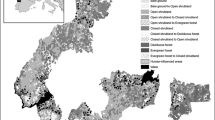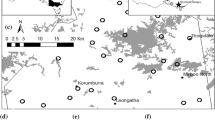Abstract
We studied the vegetational and avifaunistic changes following rural depopulation in an area covering 2,600 ha north of Montpellier (Southern France). The study area is covered by a mosaic of Mediterranean habitats that includes cultivation, grasslands, shrublands, and woodlands and is representative of the natural features present and of the human usage practiced so far in this part of the Mediterranean.
We sampled the vegetation and the bird fauna in the same 193 census plots in 1978 and in 1992. At both the habitat and landscape scales the cover of woody plants increased significantly. Open habitats tend to disappear. As a consequence the abundance of open-habitat bird species decreased significantly whereas the abundance of forest birds increased significantly. These changes favor a pool of forest species widespread in western Europe and reduce habitat availability for open habitat and shrubland species. Many of the latter are Mediterranean species whose distribution in Western Europe could become reduced under current landscape dynamics. Our observation of more woodlands and their typical birds and of less open habitats and their associated avifauna is not consistent with the traditional worry shown by the public and the managers about the regression of forests and woodlands in the Northern Mediterranean as a consequence of fire.
Similar content being viewed by others
References
Aaviksoo, K. 1993. Changes of plant cover and land use types (1950’s to 1980’s) in 3 mire reserves and their neighbourhood in Estonia. Landscape Ecology 8: 287–301.
Ales, R.F., Martin, A., Ortega, F. and Ales, E.E. 1992. Recent changes in landscape structure and function in a Mediterranean region of southwest Spain (1950–1984). Landscape Ecology 7: 3–18.
Barbero, M., Quézel, P. and Loisel, R. 1990. Les apports de la phytoécologie dans l’interprétation des changements et perturbations induits par l’homme sur les écosystèmes forestiers méditerranéens. Forêt méditerranéenne 12: 194–215.
Barry, J.P. 1960. Contribution à l’étude de la végétation de la région de Nîmes. Annales Biologiques 36: 311–540.
Blondel, J. and Farré, H. 1988. The convergent trajectories of bird communities along ecological successions in European forests. Oecologia 75: 83–93.
Blondel, J., Ferry, C. and Frochot, B. 1981. Point counts with unlimited distance.In Estimating the Numbers of Terrestrial Birds. pp. 414–420. Edited by C.J. Ralph and J.M. Scott. Studies in Avian Biology 6.
Daget, P. 1977. Le bioclimat méditerranéen: analyse des formes climatiques par le système d’Emberger. Vegetatio 34: 87–103.
Debussche, M. and Escarre, J. 1983. Carte des isohyètes interannuelles dans le Montpelliérais: document établi pour la série 1950–1979 (avec pour certaines stations les valeurs de S, m, M et Q2). C.E.F.E./C.N.R.S., Montpellier.
Debussche, M. and Hétier, J.P. 1984. Cartes physionomiques de la végétation. Région de Saint-Martin-de-Londres en 1946, 1954, 1961, 1971, 1979. C.E.F.E./C.N.R.S., IARE, Montpellier.
Debussche, M., Rambal, S. and Lepart, J. 1987. Les changements de l’occupation des terres en région méditerranéenne humide: évaluation des conséquences hydrologiques. Acta Oecologica, Oecol. Applic. 8: 317–332.
Everitt, B.S. 1977. The analysis of contingency tables. Chapman and Hall.
Groupe de Recherche Interdisciplinaire de Montpellier. 1985. Etude écologique, sociologique et économique d’une zone méditerranéenne médiane: les Garrigues du Montpelliérais. De la marginalisation à la périurbanisation. C.N.R.S., Montpellier.
Järvinen, O. and Haila, Y. 1989. Animal populations in changing Finnish forests: many unknowns in a nation-wide ecological experiment.In Ecological Impact of Acidification. pp. 39–47. Edited by I. Scabolcs. Hungarian Academy of Sciences, Budapest.
Lauga, J. and Joachim, J. 1992. Modelling the effects of forest fragmentation on certain species of forest breeding birds. Landscape Ecology 6: 183–193.
Lepart, J. and Debussche, M. 1992. Human impact on landscape patterning: Mediterranean examples.In Landscape Boundaries, Consequences for Biotic Diversity and Ecological Flows. pp. 76–106. Edited by A.J. Hansen and F. di Castri. Springer, New York.
Lepart, J. and Escarre, J. 1983. La succession végétale, mécanismes et modèles: analyse bibliographique. Bull. Ecol. 14: 133–178.
Le Roy Ladurie, E. 1966. Les paysans du Languedoc. Mouton, Paris.
Martin, J.L. and Thibault, J.C. 1996. Coexistence in Mediterranean warblers: Ecological differences or interspecific territoriality? J. Biogr. 23: 169–178.
O’Connor, R.J. and Shrubb, M. 1986. Farming and birds. Cambridge University Press, Cambridge.
Opdam, P., Rijsdijk, G. and Hustings, E. 1985. Bird communities in small woods in an agricultural landscape: effect of area and isolation. Biol. Conserv. 34: 333–352.
Pickett, S.T.A. 1989. Long-term studies: past experience and recommendations for the future.In Long-term Ecological Research, An International Perspective. pp. 71–88. Edited by P.G. Risser. John Wiley & Sons, Chichester.
Pickett, S.T.A., Collins, S.L. and Armesto, J.J. 1987. Models, mechanisms and pathways of succession. The Bot. Rev. 53: 335–371.
Prodon, R. and Lebreton, J.D. 1981. Breeding avifauna of a Mediterranean succession: the holm oak and the cork oak series in the eastern Pyrenees. 1. Analysis and modelling of the structure gradient. Oikos 37: 21–38.
Rousvoal, D. 1973. Etude du climat thermique des Cévennes. C.E.F.E./C.N.R.S., Montpellier, et Parc National des Cévennes, Florac.
SAS User’s Guide: Basics, Version 5 Edition. Cary NC: SAS Institute Inc., 1985. 1290 p.
Schwabe, A. 1991. A method for the analysis of temporal changes in vegetation pattern at the landscape level. Vegetatio 95: 1–19.
Virkkala, R. 1991a. Spatial and temporal variation in bird communities and populations in north-boreal coniferous forests: a multiscale approach. Oikos 62: 59–66.
Virkkala, R. 1991b. Population trends of forest birds in a Finnish Lapland landscape of large habitat blocs: consequences of stochastic environmental variation or regional habitat alteration? Biol. Conserv. 56: 223–240.
Vitousek, P.M. 1994. Beyond global warming: ecology and global change. Ecology 75: 1861–1876.
Yeatman-Berthelot, D. 1991. Atlas des oiseaux de France en hiver. S.O.F., Paris.
Yeatman-Berthelot, D. 1994. Nouvel atlas des oiseaux nicheurs de France. S.O.F., Paris.
Zbinden, N. and Blondel, J. 1981. Zu Raumnutzung, Territorialität und Legebeginn mediterraner Grasmücken (Sylvia melanocephala, S. sarda, S. cantillans, S. hortensis) in Südfrankreich. Der Ornithologische Beobachter 78: 217–231.
Author information
Authors and Affiliations
Rights and permissions
About this article
Cite this article
Preiss, E., Martin, JL. & Debussche, M. Rural depopulation and recent landscape changes in a Mediterranean region: Consequences to the breeding avifauna. Landscape Ecol 12, 51–61 (1997). https://doi.org/10.1007/BF02698207
Issue Date:
DOI: https://doi.org/10.1007/BF02698207




